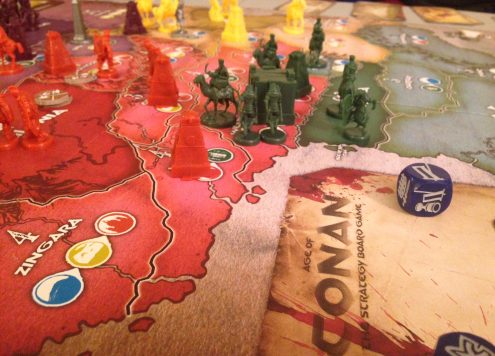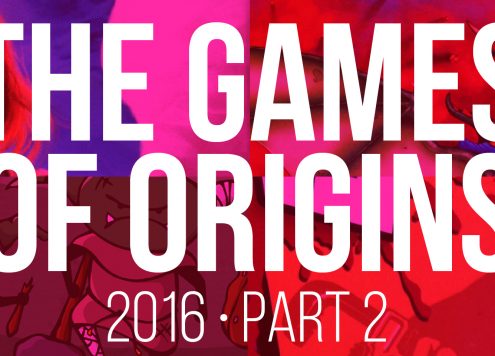ORIGINS, June 13-17 at the Greater Columbus Convention Center
by David C. Obenour and Kristofer Poland
…and that’s not all! After our first post, we’re back with more of the card-flipping, dice-rolling, identity-hiding, and hard-hitting gaming action that you’ve come to expect from our convention roundups! Here are more of the best games we got to play at Origins 2018.

Gorus Maximus (InsideUP Games)
Dave: Currently lapping its funding goal at Kickstarter (but you’ve still got a couple of weeks to get in), Gorus Maximus is a colorful card game of arena combat. It’s a trick-taking game but the twist is a stronger challenger (card) can challenge the lead and change trump mid-way through the trick. A quick, fun and action-packed style of gaming to match a quick, fun and action-packed theme with incredible splattery art from Kwanchai Moriya (Dinosaur Island, Kodama: Tree Spirits, Catacombs).
Kris: Gorus Maximus featured some of the most impressive artwork of everything I saw at Origins this year. More than just blood splatter, the cards are bright, colorful, and only dark in their humor. Gorus Maximus looks to be just as well suited for head-to-head play as it is for team games, and it has a short enough playtime to be enjoyed without ever getting tedious. Check it out!

This War of Mine (Ares Games)
Dave: While I haven’t played the video game it was based off of, Ares Games’ This War of Mine was my favorite board game of Origins this year. Set in a fictional war zone inspired by the modern day siege of Sarajevo, players work together in controlling a group of civilians trying to survive. The main area of the board is a house you have set up in to wait out the atrocities that surround you. A night and day phase allow for exploring to collect food, water and materials, building every day items like a small stoves to cook and stave off the cold, and encountering (or trying not to) other survivors and military raiding parties. An encounter book of hundreds of different situations gives a strong narrative to the game that captures the bleak reality of a side of war we rarely hear about.
Kris: I wholeheartedly agree with Dave. Playing a bit of This War of Mine was one of the best board gaming experience of this year’s show. It reminded me somewhat of Dead of Winter, only this game replaces fanciful zombies with human beings living in a war zone. Unsurprisingly, there’s a grimly realistic tone here. Things can take a wrong turn at any moment, whether defending one’s base from raiders or running into hostile survivors while scavenging through a destroyed building. War is hell, but This War of Mine offers a top-tier tabletop gaming experience.

Mammoth (Soaring Rhino)
Dave: The story behind Mammoth is a fascinating one. Scientists are currently splicing found mammoth DNA into Indian Elephants in an effort to reintroduce the species. More than just for the spectacle, the purpose of this is to take these hearty creatures to where they can trample the permafrost and reduce environmentally harmful methane emissions. What looks like a beautiful puzzle game based off of this, game designer Soaring Rhino will be donating a portion of the proceeds back into this pursuit.
Kris: Super science is no longer confined to comic book pages and television screens. Mammoth reminds us that yesterday’s impossibility is today’s reality! I didn’t get a chance to actually play the game, but I can attest to the elegance of its design. Mammoth looks great and takes pride in its intent to inform as well as entertain. Keep an eye out for this one. Who knows? You could one day tell your grandchildren about the game you played that made the world a greener place.

Vengeance (Mighty Boards)
Dave: Designed by a professor whose area of expertise includes the role of narrative in board games, Vengeance makes playable the tropes of revenge films such as Kill Bill or John Wick that make for such highly-entertaining stories. The main character is wronged, they’re deeply scared either mentally or physically, and then their journey for revenge commences. Using illustrations inspired from many of the recognizable films of this genre, there’s enough to enjoy for the average popcorn munchers and even more for the Criterion Collection crowd.
Kris: I love this theme! Revenge movies have a certain universal appeal, and it’s kind of shocking to me that we haven’t already seen a glut of tabletop titles similar to Vengeance. The cycle of play moves nicely between montages in which players train and gain power-ups that can modify dice rolls and fight sequences that take the violence directly to the sinister gangs that have wronged our heroes. Vengeance can be played solo or competitively, so everyone can easily get a taste of bloody revenge.

Reef (Plan B Games / Next Move Games)
Dave: Between Century: Eastern Wonders, Coimbra, and Reef, Plan B Games and its subsidiary Next Move Games had much of the buzz at Origins this year. Selling out of their copies of these games within the first 20 minutes daily, people were excited. As for Reef, the game is a simple but fun stacking game of brightly colored plastic bits of reef. Goal cards outline patterns for you to fight over and fulfill and average games last just over a half hour.
Kris: Reef offers simple, quick-paced puzzle action for two to four players. Its brightly colored game pieces and straightforward design offer an immediate appeal to younger and less experienced gamers. My biggest issue with it is that it feels more like multiple single-player experiences to me than a cohesive, competitive game. While I did enjoy my short amount of time with Reef, I think I’d rather play Tetris or Columns or Lumines yet again.

Micropolis (Matagot)
Dave: Ant colonies are cool. Ever since the days of playing SimAnt on my parents Gateway Computer, the structure and society of ants has been fascinating. While not an in depth exploration of these naturally occurring cultures, Micropolis is a fun game that plays with the different roles ants play in their society and the winding underground tunnels where they make their homes. As with all Matagot games, the components are wonderfully and inventively put to use, which makes for an engaging little puzzle forming game.
Kris: Nice Gateway plug, Dave. To my absolute amazement, they still exist! [editor’s note: most search related to Gateway, “Is Gateway computer company still in business?”] Micropolis puts ants in togas, and that’s good enough in and of itself. Fortunately, there’s much more to the game than just that. Selecting the right tiles, connecting tunnels that contain various fruits, and populating your colony with the proper special ants at the right time keep this one engaging throughout its brief playtime. I’d be happy to see this one show up on my table during any gaming session.

SuperHot (Grey Fox Games)
Dave: Timing is a fun mechanic to play with for board games as opposed to just players swapping back-and-forth actions for their turns. These mechanics are a perfect setting for an adaptation to the 2016 indie video game hit, SuperHot where time only progresses with the actions you take. Being more of a digital gamer than myself, I’m going to let Kris talk more about this one.
Kris: In an era of super elaborate video game to tabletop game conversions like Dark Souls and This War of Mine, it was nice to see someone take the opposite approach. SuperHot’s components include only a deck of cards and a playmat. The video game’s primary gimmick was that time only passed as players moved or attacked. This mechanic must’ve been difficult to translate into a card game, so Grey Fox deserves kudos. The video game also had a wonderfully evolving narrative, but that seems to have been deleted from this version for understandable reasons. While at its best as a single player experience, SuperHot can also be played competitively or cooperatively with a friend. Give it a shot, and download the innovative original while you’re at it!

Carthago (Capstone Games)
Dave: Set in Carthage at 800 BC, players in Carthago take on the role of merchants seeking to build the most lavish residences, a sizable fleet of trading and military vessels, and turn the best deals on the many resources from home and abroad. With so many “hot new trends” cycling through gaming over the last decade, Carthago is a fun reminder of the more classic mechanics of hand management, multi-use cards and worker placement that built board games to what they are today.
Kris: While I most definitely understand its appeal, Carthago didn’t do much for me. All it really boils down to is that it’s not my preferred style of gameplay. Additionally, its thematic elements are not the most appealing to me. That being said, I understand Dave’s enthusiasm for it. It’s a well-designed game with time-tested mechanics. If you’re looking for a worthwhile addition to your worker placement game collection, you could do a lot worse than Carthago.

Untold Adventures Await (Hub Games)
Dave: I first learned about Rory’s Story Cubes a few years back when Hub Games (known then as The Creativity Hub) was giving out copies to press at one of the conventions. Nine dice with a variety of different simple image faces, they were pushing the endless creative possibilities of the crowd-sourced games, teaching tools and more that you could use them. More directly channeling this creativity, Hub Games have now created a RPG system that streamlines the rules to get you right into your immersive story. Lots of games have promised this, but Untold Adventures Await provides enough guides that you don’t all need to be improv actors for the action to be compelling. Kris actually played this game with his family, so I’ll let him delve deeper.
Kris: While I find Rory’s Story Cubes to be better educational tools than games in and of themselves, Untold Adventures Await unlocks their true gaming potential. The fact that I was able to corral three septuagenarians, three college students, and two professionals into playing what is essentially a roleplaying game during a family vacation is a testament to this game’s ease of play. It takes away all of the complicated stats and dice rolls of D&D or Shadowrun and replaces them with the roots of roleplaying: cooperative storytelling. Another brilliant aspect of Untold is that it frames things in a very relatable way. It’s so much easier selling the notion of co-creating an episodic television series to novice or intermediate gamers than it would ever be to get them to even roll up characters. While the hardcore amongst us will never abandon Pathfinder for Untold, this game is an unquestionable triumph.

Boom, Bang, Gold (HABA)
Dave: When people ask me about Origins, Boom, Bang, Gold is one of the first games I tell them about. Games are ultimately toys and toys don’t get much more fun and imaginative than this one. With a false bottom on the gamebox, treasure tiles are arranged on top facedown. Players than take turns chucking their wooden dynamite sticks at the false bottom, flipping over and revealing treasure to quickly snatch up – just watch out for the rats!
Kris: HABA makes some of the best games for the younger set I’ve ever seen. Boom, Bang, Gold is no exception. It’s simple, it’s straightforward, and it’s exciting! Two to four players compete to collect gold nuggets during the gold rush. Less about dexterity than keen eyesight, this one also includes plenty of shouting and interactivity amongst players that will certainly help keep kids engaged until the game’s end.

Summit: The Board Game (InsideUP Games)
Dave: I seem to remember a prototype of Summit from Gen Con in 2017, but honestly (and somewhat surprisingly) mountains and mountain climbing have become a trend in gaming. Not on the same level as say Cthulhlu or the ubiquitous “adults-only” versions of games, but still a noticeable amount of games. If it is the same game, than the transition from the drawing board to finished product was amazing. With stark black angular lines that feel almost Nordic in design, Summit is a beautiful game. Players race from base camp to the titular summit and back again, with varying weather, obstacles, rope tile segments, and most interestingly, a karma track that keeps track of each helpful and hindering move. Definitely a lot to explore!
Kris: Summit looks great! The aesthetic is almost brutalist in its presentation, and that works well with its theme of survival in the harshest of natural conditions. It boasts solo, cooperative and competitive play for up to six players. Summit offers a lot of variables to keep things interesting and ensure no two games will ever be the same. One game session can fill an entire evening though, so be prepared for a long fight to the peak.

Dungeon Raiders (Devir)
Dave: A fairly simple dungeon diver card game, it’s time to face dangers known and unspeakable in search of fame, wealth and glory! Part of a motley crew of adventurers, the deeper you go the greater the risk and reward. Of course, even though you’re all in it together, that doesn’t mean the treasure always gets divided evenly. Help in battle when needed, get grabby in the treasure chest when it suits you, and be sure you’re not the weakest one in the party. Goofy art and themes (one of the head villains is a tax collector), Dungeon Raiders isn’t meant to be taken too seriously.
Kris: Dungeons Raiders reminds me of Welcome to the Dungeon with a few extra mechanics thrown in. It’s a multiplayer game for three to five players that mixes elements of cooperative and competitive play. All but the most injured player may escape the dungeon after defeating the final boss, but only the raider who collected the most gold can claim victory. There’s nothing revolutionary here, but it was still pretty fun.
That’s a wrap for Origins 2018! Be sure to come back for more gaming features, reviews and interviews, in addition to in late August when we bring you even more new and new-to-us games from Gen Con in Indianapolis.









Social Media